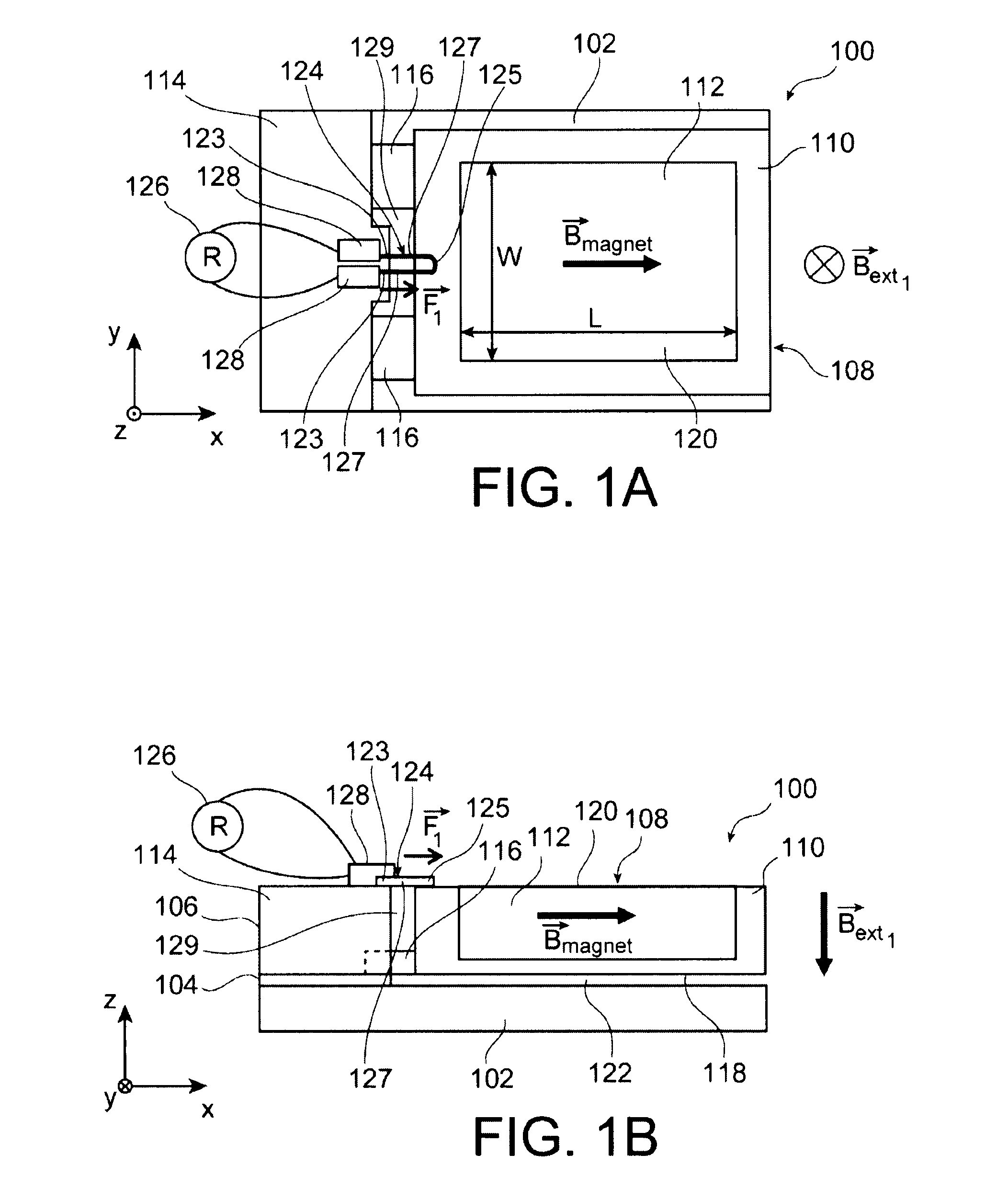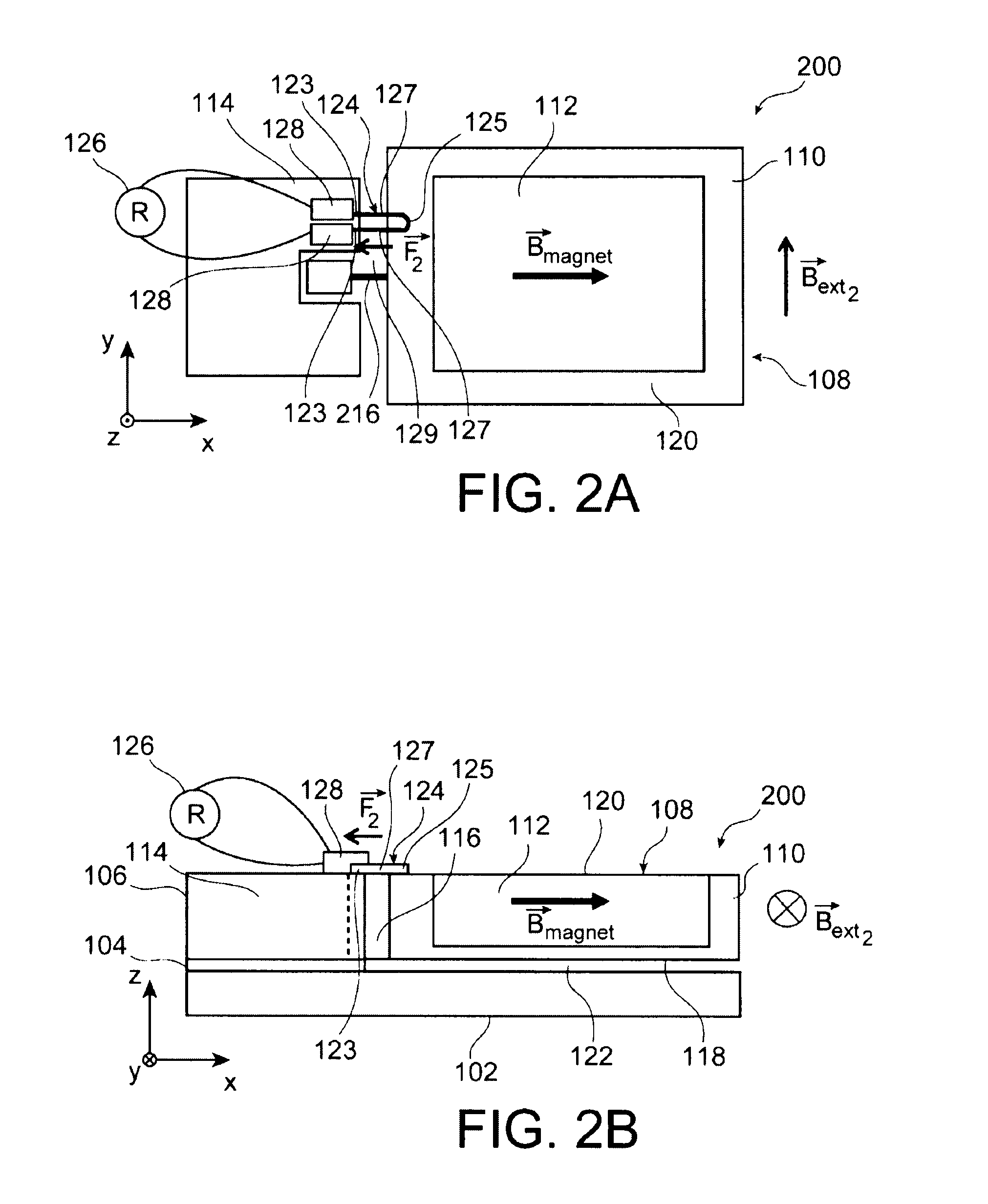Magnetic field sensor with suspended stress gauge
a stress gauge and magnetic field technology, applied in the field of magnetic field sensors, can solve the problems of high energy consumption of other types of sensors, inability to adapt to perform certain magnetic field measurements, and the production of such sensors becomes much more complex. , to achieve the effect of strong magnetic sensitivity
- Summary
- Abstract
- Description
- Claims
- Application Information
AI Technical Summary
Benefits of technology
Problems solved by technology
Method used
Image
Examples
first embodiment
[0084]One example of a magnetic field sensor 100 will be described in connection with FIGS. 1A and 1B, which respectively show a top view and a profile view of the sensor 100.
[0085]The sensor 100 is made from a SOI substrate having a stack formed by a support layer 102 composed of semiconductor, a dielectric layer 104 and a superficial layer 106 also composed of semiconductor. The semiconductor of the layers 102 and 106 is for example monocrystalline or polycrystalline silicon. The superficial layer 106 could also be composed of SiGe or any other material of III-V type. The dielectric layer 104 is for example composed of SiO2. In one alternative, the sensor 100 could be made from another type of substrate (bulk, semiconductor on glass, . . . ).
[0086]The sensor 100 has a body 108 forming a mobile portion of the sensor 100 and comprising magnetic means able to move the body 108 by the action of a magnetic field. In this first embodiment, the body 108 has a box 110 formed in the super...
second embodiment
[0103]One example of a magnetic field sensor 200 will be described relative to FIGS. 2A and 2B, which respectively show a top view and a profile view of the sensor 200.
[0104]Similarly to the sensor 100 according to the first embodiment, the sensor 200 is made from a SOI substrate having layers 102, 104 and 106 (not shown in FIG. 2A), and comprises the body 108, the inlay portion 114, the stress gauge 124 and the measuring means 126.
[0105]Relative to the sensor 100, the sensor 200 is not intended to detect a magnetic field perpendicular to the plane of the sensor 200 (similar to the plane of the sensor 100 and parallel to the plane (X,Y)), but a magnetic field Bext2 oriented in the plane of the sensor 200, here parallel to the Y axis, and perpendicular to the magnetization direction Bmagnet.
[0106]To perform such a detection, the body 108 is not connected to the inlay zone 114 by the two hinges 116, but by a single hinge 216 connected to the body 108 over the entire thickness thereof...
third embodiment
[0113]One example of this magnetic field sensor 300 will be described in connection with FIGS. 5A and 5B, which respectively show a top view and a profile view of the sensor 300.
[0114]This sensor 300 has a first detection structure 100a similar to the sensor 100 previously described. Moreover, the sensor 300 also has a second detection structure 100b having the same elements as the first detection structure 100a, but arranged differently. The bodies 108a and 108b of the two detection structures 100a and 100b are similar, the ferromagnetic materials 112a and 112b of the two structures 100a, 100b having the same magnetization direction (Bmagnet) oriented parallel to the Z axis. However, the other elements of the two detection structures 100a and 100b, i.e. the inlay portions 114a, 114b, the hinges 116a, 116b, the detection means 124a, 124b and the electric contacts 128a, 128b are arranged axially symmetrically to each other relative to the others along an axis perpendicular to the pl...
PUM
| Property | Measurement | Unit |
|---|---|---|
| thickness | aaaaa | aaaaa |
| thickness | aaaaa | aaaaa |
| thickness | aaaaa | aaaaa |
Abstract
Description
Claims
Application Information
 Login to View More
Login to View More - R&D
- Intellectual Property
- Life Sciences
- Materials
- Tech Scout
- Unparalleled Data Quality
- Higher Quality Content
- 60% Fewer Hallucinations
Browse by: Latest US Patents, China's latest patents, Technical Efficacy Thesaurus, Application Domain, Technology Topic, Popular Technical Reports.
© 2025 PatSnap. All rights reserved.Legal|Privacy policy|Modern Slavery Act Transparency Statement|Sitemap|About US| Contact US: help@patsnap.com



